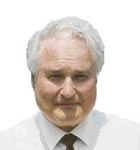Abstract
Pulmonary hemodynamics is studied in terms of the quasi one-dimensional unsteady nonlinear fluid flow equations which are applied to the 40-odd generations of branched arterial, capillary and venous distensible vessel segments making up the four lobes of the complete lung. An idealized pressure-area "tube law" is introduced which provides for varying degrees of vessel collapse. The model predictions agree well with experimental measurements of flow transmission as a function of pulsatile frequency. Pulmonary response is represented schematically in terms of an influence diagram. Pressure pulses are shown to increase in amplitude in the early arterial segments, with the greatest drop occurring across the capillary bed.
1. Introduction
The lung constitutes a highly complex and selfregulating system for oxygenating man�s blood and removing its waste materials. It is at the alveolar level that the respiratory and circulatory functions interact and the important exchange processes occur. Much research has been done on both aspects of pulmonary function by physiologists, medical clinicians and applied
mathematicians. It is evident from this work that mechanical principles play a very important role. Neural control is nonetheless present, although less prominent than in the systemic circulation. Its direct effect may enter, however, through a readjustment of the mechanical variables of the system.
It is particularly the circulatory aspects of pulmonary function which are of concern in the present investigation. We address ourselves here to the general question of how the lung might adapt to external influences, caused for example, by cardiac dysfunction (mitral stenosis, left-to-right shunts), vascular obstructions (emboli transported to the lungs from the systemic veins), changes in altitude (alterations in alveolar pressure in mountain-climbers and deep-sea divers) and physical work and exercise. A good quantitative understanding of pulmonary response is still lacking to this date, although a number of very imaginative experiments have been undertaken to document this behaviour. Less work has been done on the unification of this data in the form of a global quantitative model of the complete circulatory system of the lung on the basis of classical mechanical principles.
Some may be of the opinion that such an undertaking is premature. tndeed, very little detailed and utilizable information is available for the material properties on which the results of such an analysis must depend. Direct measurements of in vivo dimensions and mechanical properties of the intricate branching network have been accomplished only for the main pulmonary artery and its early branches. Beyond, this point, the calibre of the vessels rapidly diminishes. Nor can the vascular beds be laid out in thin sheets so that their in-vivo behaviour may be examined dynamically under a microscope. The anatomy of the rabbit�s ear may readily lend itself to such experimentation, but the lung is highly threedimensional in structure.
Partial circumvention of this difficulty is possible by injection into the blood-stream of a substance which is at first convected and then solidifies within the blood vessels, hopefully without changing their dimensions. Measurements are then made directly on the cast of the pulmonary tree of the sacrificed animal.
Similar difficulties apply to measurements of transmural pressure beyond the first and last few generations. Reliance on venous "wedge" pressures, obtained by occluding the vessel to the point of arresting the flow, is less than satisfying, for some doubt always remains about their correct interpretation. Flow measurements in the interior of the lung have been carried out recording the radiation from gaseous radioactive tracers, such as xenon-133, which may be injected into the blood-stream and detected by an external counter. One thus obtains an integrated measure across a slice of the lung.
In spite of this somewhat pessimistic picture, useful estimates have been made in the intermediate regions of the lung, which serve as a starting point for a mathematical analysis. One may cite the now classical studies of lung morphology by Weibel(1963) and the more recent findings of Cummings et al. (1969). However the results of Wiener et al. (1966) offer the considerable advantage of accompanying their estimations of vessel dimensions by values of the corresponding vessel compliances.
Useful measurements of pressure and blood flow in different regions of the lung under varying conditions of flow pulsatility have been published by Attinger (1963), West et al. (1964) and Maloney et al. (1968). Mathematical modelling of the pulmonary circulation has been attempted at various levels of detail. Global response has been simulated by a great many investigators (for example, Rideout and Katra, 1969) on the basis of the analogy of the linearized equations of motion with an electrical transmission line. The notions of resistance or impedance connected with this simplified formulation have found great popularity amongst physiologists who find such physically intuitiveconcepts useful in their quest for an understanding of the fundamental underlying mechanisms of pulmonary behaviour. One must nonetheless proceed with caution in interpreting the results of such formulations which often do not deal adequately with important intrinsically nonlinear characteristics such as wave steepening and hence the growth of pressure amplitudes observed along the arterial segments of the circulatory system.
A more realistic approach requires retaining the important nonlinear inertial terms in the fluid equations of motion. The resulting system is of second order, and hyperbolic in character, provided that the transmural pressure is considered to be a function of local cross-sectional area only. It may be solved numerically by finite differences or by the method of characteristics. The latter technique has been employed by Anliker et al. (1971) for the systemic circulation. Since it is difficult to include the complete systemic circulatory system in such calculations, provision must be made for outflows from the model system, by means of continuous or distributed sinks. A similar procedure has been adopted here, with the added advantage that the complete pulmonary anatomy may be inciuded in the model, thus obviating the need for such pre-specified sink terms.
It has long been recognized that distensible blood vessels may collapse, at least partially, under physiological flow conditions. Such vessels become approximately elliptical in cross-section, the ratio of major-to-minor axes ranging in dogs from 1.25 in the main pulmonary artery to 1.91 within the next five arterial generations, These measurements of Attinger (1963) correspond to equivalent cross-sectional area ratios of 0.72-0.82 between elliptic and circular configurations. Attinger concludes that these ratios at the major branch points are considerably less than those postulated for optimal energy transfer. One is thus led to surmise that collapsible vessels, which disadvantage the efficient transmission of energy, may be playing another role, for which that is the price.
The suggestion that the purpose of collapsible pulmonary capillaries may be to control the flow, as a "Starling" resistor, was first introduced by Permutt et al. (1962). They regarded such collapsible vessels, subjected to upstream arterial, downstream venous and surrounding alveolar pressures, as sensitive sluicegates which open or close in response to these three forces. West et al. (1964) have extended this idea to define three control-zones in the lung: . . . Continue to article and footnotes (PDF).










